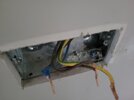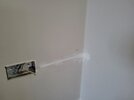Hi,
In the new home I moved into I have realized that one spur socket does not work. Looking into it, it turns out that spur socket has its wiring chopped off in the main socket the spur socket was meant to be connected to (why would someone do that, having gone through the pain of getting a conduit with wire in is beyond my imagination ).
).
Attached is a pic of the main socket, showing the wiring from the spur socket being chopped off, and a pic of the wall where you can see the path of the conduit by following the filler...
Now, how would I go about pulling that wire out and installing a new one so that I make the spur socket properly powered? I have tried pulling the wire from the spur socket end but I think the 90 degrees angle that you can see from the path that the filler does is not actually helping...
Thanks
In the new home I moved into I have realized that one spur socket does not work. Looking into it, it turns out that spur socket has its wiring chopped off in the main socket the spur socket was meant to be connected to (why would someone do that, having gone through the pain of getting a conduit with wire in is beyond my imagination
Attached is a pic of the main socket, showing the wiring from the spur socket being chopped off, and a pic of the wall where you can see the path of the conduit by following the filler...
Now, how would I go about pulling that wire out and installing a new one so that I make the spur socket properly powered? I have tried pulling the wire from the spur socket end but I think the 90 degrees angle that you can see from the path that the filler does is not actually helping...
Thanks



